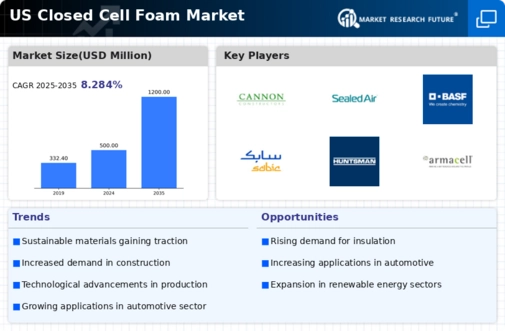The US Closed Cell Foam Market is characterized by intense competition as numerous players strive to enhance their market share while catering to a diverse range of applications, including insulation, marine, automotive, and packaging. This segment has seen consistent growth driven by the increasing demand for lightweight, durable, and thermally efficient materials.
As companies continue to innovate with advanced manufacturing techniques and novel product formulations, they are also focusing on sustainability and eco-friendliness, which shapes product development and marketing strategies. The competitive landscape is further influenced by factors such as pricing strategies, geographical presence, and the ability to provide customized solutions that meet the specific needs of various industries.
As such, companies in this market must remain agile and responsive to customer needs and market trends to maintain their competitive edge. General Plastics Manufacturing Company plays a pivotal role in the US Closed Cell Foam Market, known for its commitment to quality and innovation. The company has established a strong market presence through its extensive range of closed cell foam products that cater to various industries, including aerospace, defense, and automotive.
The strengths of General Plastics Manufacturing Company lie in its advanced manufacturing capabilities and the ability to create high-performance foams that offer superior insulation and shock absorption properties. The company is dedicated to meeting strict industry standards, which not only bolsters its reputation but also fosters long-term relationships with clients.
By emphasizing research and development, General Plastics Manufacturing Company is able to continuously improve its product offerings, ensuring that they remain at the forefront of technological advancements in the closed cell foam sector.
Cannon Group has established a significant footprint in the US Closed Cell Foam Market, leveraging its expertise in producing innovative foam solutions tailored to a wide variety of applications. Known for its high-performance products, Cannon Group focuses on delivering closed cell foams that exhibit excellent thermal insulation and resilience, making them ideal for sectors such as construction, personal protective equipment, and transportation.
The strengths of Cannon Group include its robust research and development capabilities, which allow the company to introduce novel products that meet evolving customer demands. Additionally, Cannon Group has actively engaged in strategic mergers and acquisitions to strengthen its market presence and broaden its product portfolio.
This approach has enabled Cannon to enhance its operational efficiency and expand its customer base in the US, driving growth while ensuring that it continues to deliver high-quality solutions in the closed cell foam market.





















Leave a Comment